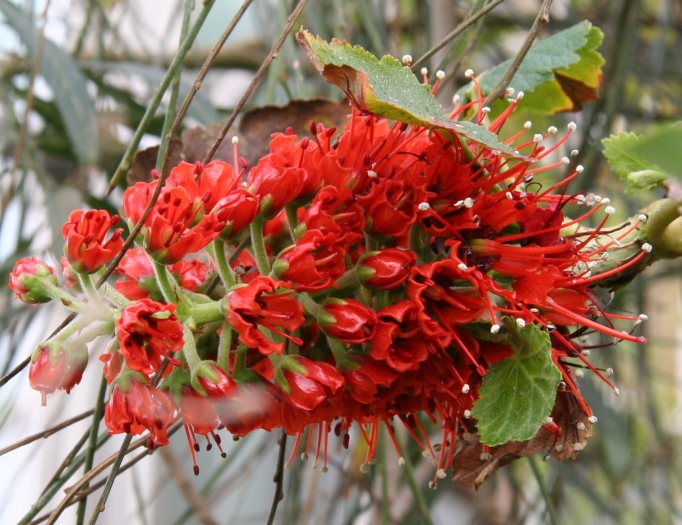Natal Bottlebrush
(Greyia sutherlandii)
Natal Bottlebrush (Greyia sutherlandii)
/
/

Michael Wolf
CC BY-SA 3.0
Image By:
Michael Wolf
Recorded By:
Copyright:
CC BY-SA 3.0
Copyright Notice:
Photo by: Michael Wolf | License Type: CC BY-SA 3.0 | License URL: https://creativecommons.org/licenses/by-sa/3.0 | Uploader: Michael w | Publisher: Wikimedia Commons | Title: Greyia_sutherlandii2.jpg | Notes: {{Information |Description= [[Gymnocalycium baldianum]] |Source=[http://www.flickr.com/photos/17884028@N00/133540604/ Flores de cactus] |Date=April 21, 2006 |Author=[http://www.flickr.com/people/17884028@N00 Daniel Sancho] from Málaga, Spain |Pe |































Estimated Native Range
Summary
Greyia sutherlandii, commonly known as Natal Bottlebrush, is a deciduous small tree or large shrub native to the rocky slopes and grasslands of the Drakensberg mountains in Southern Africa. It typically grows to a height and width of 6-9 feet (1.8-2.7 meters), with a rounded canopy and a single trunk or multiple stems. The leaves are broad and leathery, providing a lush appearance even when the plant is not in flower. The Natal Bottlebrush is renowned for its vibrant red, brush-like flowers that bloom in the spring and early summer, attracting birds and insects to the garden. The flowers are followed by woody capsules that persist on the plant.
This plant is valued for its drought tolerance and striking floral display, making it an excellent choice for water-wise gardens and xeriscaping. It is often used as a focal point in the landscape, in shrub borders, or as a screen. Greyia sutherlandii thrives in full sun and requires well-drained soil, preferably with some organic content. It is relatively low-maintenance but may benefit from occasional pruning to maintain its shape and promote flowering. While it is generally pest-free, it can be susceptible to root rot if overwatered or planted in poorly drained soils.CC BY-SA 4.0
This plant is valued for its drought tolerance and striking floral display, making it an excellent choice for water-wise gardens and xeriscaping. It is often used as a focal point in the landscape, in shrub borders, or as a screen. Greyia sutherlandii thrives in full sun and requires well-drained soil, preferably with some organic content. It is relatively low-maintenance but may benefit from occasional pruning to maintain its shape and promote flowering. While it is generally pest-free, it can be susceptible to root rot if overwatered or planted in poorly drained soils.CC BY-SA 4.0
Plant Description
- Plant Type: Shrub
- Height: 6-15 feet
- Width: 6-10 feet
- Growth Rate: Moderate
- Flower Color: Red
- Flowering Season: Spring, Summer
- Leaf Retention: Deciduous
Growth Requirements
- Sun: Full Sun
- Water: Low
- Drainage: Medium, Fast
Common Uses
Bee Garden, Bird Garden, Drought Tolerant, Hummingbird Garden, Low Maintenance, Showy Flowers
Natural Habitat
Rocky slopes and grasslands of the Drakensberg mountains
Other Names
Common Names:
Scientific Names: , Greyia sutherlandii,
GBIF Accepted Name: Greyia sutherlandii Hook. & Harv.